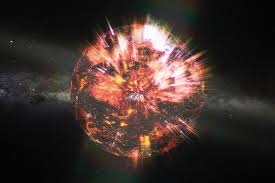
In News
A study by the Indian Institute of Astrophysics (IIA) has solved the evolution mystery of Helium stars.
In-Detail
- A study by the Indian Institute of Astrophysics (IIA), an autonomous institute of Department of Science and Technology had solved the evolution mystery of hot Helium stars (EHes).
- For the first time, researchers identified singly ionized fluorine of hot extreme helium stars.
- This research shows the main formation of these stars is by the merger of a carbon-oxygen (CO) and a Helium (He) white dwarf.
- The singly ionized fluorine (F II) has a very high enrichment of fluorine. This is a factor of about 100 to 10000 times higher than normal stars.
- The scientists explored the relationship of hot EHes with the cooler EHes, based on their fluorine abundance and established an evolutionary connection.
- For obtaining high resolution of EHs, Hanle Echelle Spectrograph (HESP)mounted on 2-m Himalayan Chandra Telescope at the Indian Institute of Astronomical Observatory (IAO) in Hanle, Ladakh and is operated remotely by IIA along with data from McDonald Observatory, USA has been used.
- By comparing the observations, the study shows that fluorine is profusely produced during the merger of a He-CO WD resulting in carbon-rich EHe whereas the He-He-WD merger results in poor carbon EHes and does not have any fluorine.
About Helium Star
- Helium (EH), an extreme star, is a low mass supergiant and is devoid of hydrogen.
- So far 21 extreme helium stars were detectedin the galaxy.
- The origin and evolution of the hot hydrogen deficient objects is a mystery.
- Their chemical compositions are very peculiar that does not match with the low mass evolved stars.
The Chandra Telescope
- The Himalayan Chandra Telescope or Indian Astronomical Observatory is located in Hanle, Ladakh.
- It is one of the world’s highest locations for astronomical observations.
- The telescope is used to observe the universe in optical, gamma rays and infrared.
- It has a diameter of 2.01m.
Conclusion
The study solved the decades-old mystery on the evolution of the hot EHes. It places hot EHes in an evolutionary sequence with cool EHes and involves the merger of two double degenerate white dwarfs (WDs).
The research also shows the capacity of Indian scientists to undertake advanced astrophysical research.

Leave a Reply
You must be logged in to post a comment.